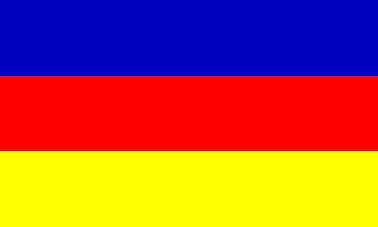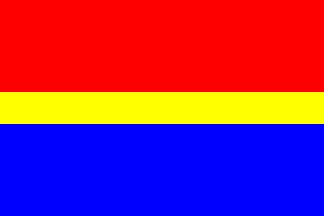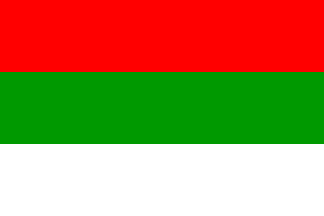![[Flags from the Battle at Guraslau (1601)]](../images/r/ro_1601.jpg) image by Alex Danes, 23 July 2008
image by Alex Danes, 23 July 2008[Click on image for larger version.]

Last modified: 2025-01-11 by alex danes
Keywords: transylvania | romania |
Links: FOTW homepage |
search |
disclaimer and copyright |
write us |
mirrors
See also:
![[Flags from the Battle at Guraslau (1601)]](../images/r/ro_1601.jpg) image by Alex Danes, 23 July 2008
image by Alex Danes, 23 July 2008
[Click on image for larger
version.]
On 3 August 1601, Prince Michael the Brave of Wallachia, allied with the
imperial general Giorgio Basta, defeated at Guraslau (in Transylvania) the
army of prince Sigismund Báthory, who had, apart from Transylvanians, help
from units from Prince Ieremia Movila of Moldavia, from the Turks, Tatars and
perhaps Poles. The very next day, prince Michael sent the Holy Roman Emperor
Rudolph II, at Prague, 88 flags, while general Basta send him only 22. All
these 110 flags were painted and described by the Austrian artillerist Georg
Puchner on 21 August 1601. The water colour painting is found today in the
Library of Dresden, Germany, volume G. 81. The image above is just a
selection of these flags.
According to the manuscript, the first flag,
resembling a Turkish pahsa ensign (tüy / tugh), belongs to a Tatar commander (mïrza).
The second
is the flag of Ieremia Movila (and of Moldavia at that time) (nr.
10), with Moldavian coat of arms in the middle and his princely title in
canton and the year 1601. There are 35 Transylvanian flags, bearing the arms
of Báthory family, three wolf fangs (nr. 6, 9, 12, 13, 18, 19), 2 flags of Braşov
city (nr. 1 and 7), one of Sighişoara city, one of Târgu Mureş (nr.
14). I believe nr. 5 is a Polish one. The Tatar and Turkish flags have Arab
inscriptions or the crescent and star on them (nr. 2, 3, 16 and I'm not sure
about nr. 8). Nr. 20 and 21 are similar, with their Zulfikar (Dhu'l-Fakar)
sword, like in the Selim I's red standard. I have no
information about flags nr. 4, 11, 15 and 17. Except the first two
flags (of the Tatar commander and Ieremia Movila), 72 belongs to cavalry
units and 36 to infantry.
Other 1601 flags can be seen on this contemporary engraving:
http://upload.wikimedia.org/wikipedia/commons/f/ff/Guraslau1601.jpg. The
flags in the front and on the right are Transylvanians. The flags on the left
are Wallachians.
Alex Danes, 23 July 2008
 image by
Alexandru Dan Mândru, 29 August 2007
image by
Alexandru Dan Mândru, 29 August 2007
The flag used in the Principality of Transylvania between 1765 and 1918. It
resembles the Coat of Arms of the principality i.e. its tinctures. It is a
horizontal tricolour, blue-red-yellow, with a possible ratio of 3:5. It was
definitely not 1:2, but one cannot find out its exact details because all we
know today is due to historic reconstructions.
Alexandru Dan Mândru, 29 August 2007
 image by António Martins-Tuválkin, 8 November 2005
image by António Martins-Tuválkin, 8 November 2005
The flag of Transylvania was red-yellow-blue, horizontally divided - the
yellow was smaller than red (and the blue). Source: Book: "A székelyek nyomában;
Budapest 1981"
István Molnár, 9 January 2002
The gold Sun and Moon in the blue field relates to the Szekely's (Hungarian peoples in Harghita-Covasna-Mures counties today (formerly Székely Land). The Black Eagle relates to the Hungarians (of course the noble Hungarians). The seven castle in the yellow field relate to the Saxon settlers who lived in Transylvania from the Middle Ages to the Ceausescu era.
Transylvania became grand-duchy on 2nd of November 1765 by Queen Maria Theresa Queen of Hungary. Transylvania was grand-duchy 1765-1848 and 1849-1867.
István Molnár, 26 November 2000
The Coat of Arms of the Transylvanian princes: http://www.medibit.hu/Historia/fejedelmekbody.html
István Molnár, 11 January 2001
 image by António Martins-Tuválkin, 9 November 2005
image by António Martins-Tuválkin, 9 November 2005
The Transylvanian national flag, the flag adopted in 1918, is a horizontal
tricolor of red, green, and white. This is from
Minahan (1996) "Nations Without States, Greenwood Press, 1996. pg 579. I
know this text is infamous for not showing the flags in color or for listing
separate flag sources, but this is one of the very few times in the book where
he mentions a date of a flag adoption (during its brief period of independence
28 Oct 1918 - 1 Dec 1918).
Ben Cahoon, 9 November 2005
 image by
Alexandru Dan Mândru, 29 August 2007
image by
Alexandru Dan Mândru, 29 August 2007
A flag used by Transylvanians of Romanian ethnicity within the Revolution of
1848. The golden inscription on white says "Virtutea Romana Reinviata" (in
Romanian), or "Virtus Romana Rediviva" (in Latin), meaning "Revived Roman
Virtue". Some Romanian historians say that the role of the golden inscription
was to express the affiliation between Transylvanians of Romanian ethnicity and
Romanians from the Danubian Principalities (that is Moldavia and Wallachia), but
this is a highly argued subject among historians.
Alexandru Dan Mândru, 29 August 2007
A picture of another flag which is found at the National Museum of History in Bucharest:
http://www.cimec.ro/scripts/PCN/Clasate/detaliu.asp?k=B9428902CCCE4C03892009FE3789AA0A
Alex Danes, 18 January 2008
Another flag is reported at
http://www.flaggenparadies.de/europa/flagge-siebenbuergen-rumaenien-transsilvanien.html
- blue-red-yellow with a coat of arms centred.
Dennis Goller, 8 April 2007
This looks to me like a modern variant bringing together the Transylvanian
colours (b-r-y) with the arms. I doubt that this was in widespread use in
pre-1918 times.
M. Schmöger, 14 April 2007